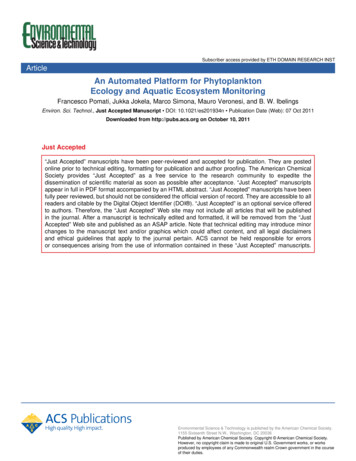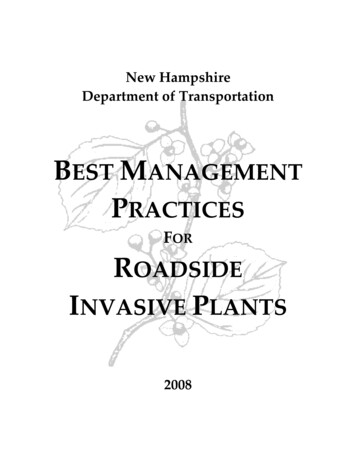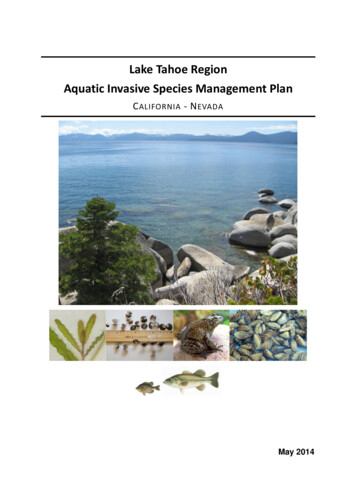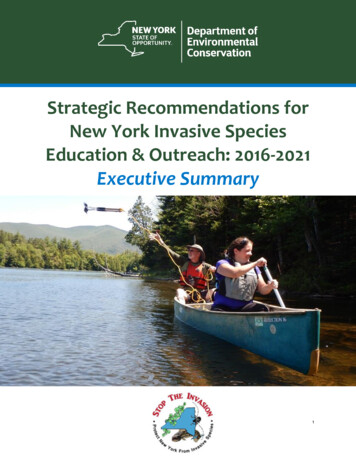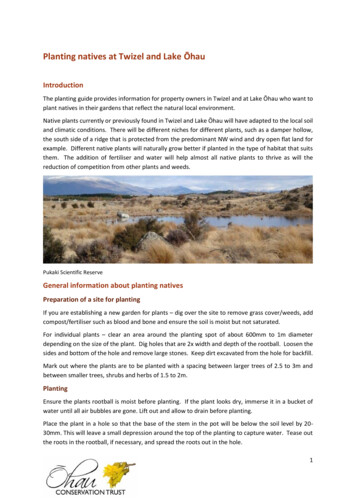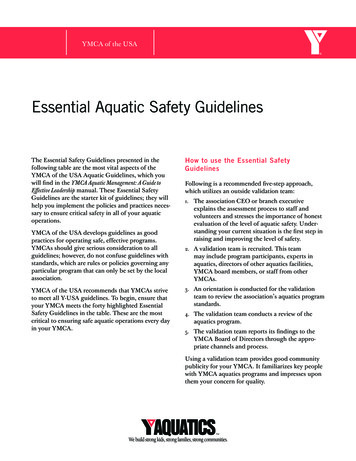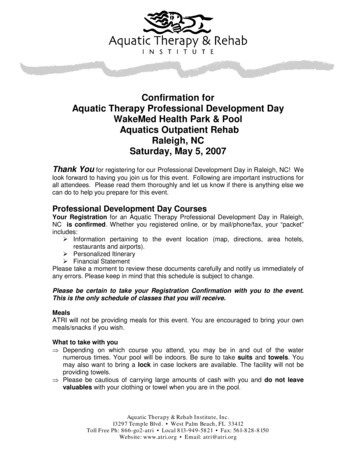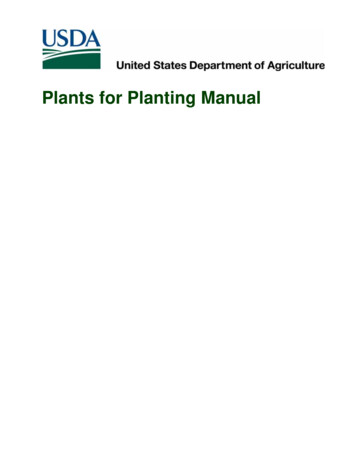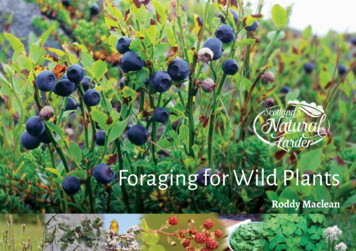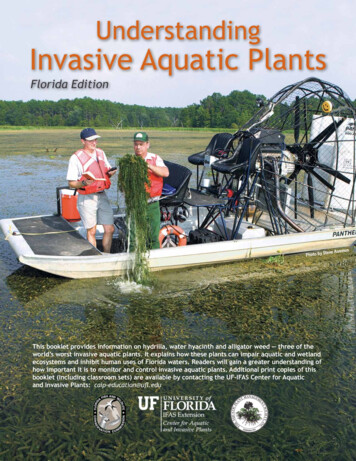
Transcription
UnderstandingInvasive Aquatic PlantsFlorida Editionusteve AusmPhoto by SThis booklet provides information on hydrilla, water hyacinth and alligator weed — three of theworld’s worst invasive aquatic plants. It explains how these plants can impair aquatic and wetlandecosystems and inhibit human uses of Florida waters. Readers will gain a greater understanding ofhow important it is to monitor and control invasive aquatic plants. Additional print copies of thisbooklet (including classroom sets) are available by contacting the UF-IFAS Center for Aquaticand Invasive Plants: caip-education@ufl.edu
What is an Invasive Aquatic Plant?Plants that live, grow, and reproduce in water are calledaquatic plants. Aquatic plants grow in a variety ofdifferent forms. Emersed plants grow rooted in shallowwater along shorelines with most of the plant sticking upout of the water. Free-floating plants drift across watersurfaces because their roots do not attach to the soils.Floating-leaved plants may or may not be anchored tothe bottom but have leaves that float on the surface of thewater (water lilies are a good example). Submersed plantsare aquatic plants that grow almost entirely under water.Invasive plants share several common traits: They grow fast and spread across large areas. They reproduce in several ways including seeds,buds, fragments, and shoots from roots. They survive in many different temperature, light,water, and soil conditions. They are difficult to control, and once established,are nearly impossible to eradicate.Although the number of invasive plants is small, the costsare huge to the economy and the environment.Native Aquatic PlantsPlants that occur naturally in a geographic area or regionare said to be native. Native plants are a natural part oflakes, rivers, and wetlands and play several importantroles in maintaining healthy aquatic ecosystems.For example, in the United States: Invasive plant damage and management costsexceed 30 billion each year. Invasive plants cover about 100 million acres,a land mass about the size of California.Native plants provide: Shelter for fish, birds, and other wildlife; Habitat for insects that are eaten by fish; Protection of shorelines from erosion; Improved water quality.Invasive Aquatic Plant ProblemsNative aquatic plants seldom cause problemsbecause they have adapted to one another and theirenvironments over thousands of years. Many differentinsects and diseases also evolved with and controlnative plants, keeping them from becoming problems.The delicate balance in native plant communities isoften damaged when people introduce fast-growinginvasive aquatic plants from other areas without thecontrols that keep them in check in their home waters.Non-Native Aquatic PlantsPlants that are moved to other areas, either on purposeor by accident, are called non-native, exotic or alien.We move plants from one location to another for manyreasons including food for ourselves and for livestock, orbecause of the plant’s unusual or beautiful appearance.Most crops grown in the United States were brought fromother continents. Examples include wheat from Asia, oatsfrom Europe, and potatoes from South America. Waterhyacinth is an example of a plant that was introduced tothe United States because of its decorative qualities.There is a difference between weedsand invasive plants:Weeds are plants that grow where they arenot wanted by humans. Invasive plants causeeconomic or environmental harm.If left unmanaged, invasive aquaticplants can:Invasive PlantsMost non-native plants brought to the United Statesprovide great benefit, and only a few grow outside theareas where they are planted. If a plant species is ableto live outside cultivation and cause environmental oreconomic harm, it is invasive. A general rule is that about1% of the plants introduced into the United States maybecome invasive in agricultural or natural ecosystems. Damage crops; Smother fish and wildlife habitat; Block navigation and flood control; Prevent recreational activities (boating, fishing,swimming); Reduce tourism and property values; Clog drinking, irrigation and hydroelectricpower water pipes.2
Managing Invasive Aquatic PlantsPreventionThe most effective way to reduce invasive aquaticplant problems is to prevent their introduction. This ismuch more difficult than it may seem. Americanslove different or unusual plants (and pets), and it isdifficult to predict which may become problemsbefore they are brought into the United States.Biological control: Organisms, usually insectsor plant diseases, are used to feed on all or part ofan invasive plant, to weaken it and slow its growth.Nearly a dozen biological controls have beenstudied and released to manage the invasive aquaticplants included in this booklet.Chemical control: Chemicals called herbicidesare tested for safety and registered with the UnitedStates Environmental Protection Agency to controlinvasive plants. Fourteen types of herbicides areapproved for use in public lakes and rivers tomanage the invasive aquatic plants in this booklet.Herbicides can be applied by boat, for small areas inlakes and rivers and by aircraft for large areas.Early Detection and Rapid ResponseOnce invasive plants become widely dispersed withina water body or across a large region, eradicatingthem becomes difficult and often impossible.Ecosystem managers frequently inspect waters forknown invasive plants and watch for plants that appearto be new to the ecosystem. When invasive plantsare discovered, management programs must beginimmediately to reduce environmental damage andeconomic costs.Mechanical control: Depending on plants andconditions in the water body, many different kindsof machines cut, chop, shred, slurry, press, transport,and remove invasive aquatic plants.Keeping Things Under ControlNatural controls like diseases, herbivores, or climatemay reduce a plant’s growth in its native habitat andkeep it from becoming too abundant. Without thesecontrols, some non-native plants thrive and becomeinvasive in their new surroundings. Aquatic plantmanagers use the following methods to keep invasiveaquatic plants under control.Physical control: Hand-pulling or temporarilychanging the environment is another method used tocontrol invasive plants. Changes include reducinglight penetration in the water with dyes; loweringwater levels in the winter to freeze, dry, and thenburn the plants; and raising water levels to shadeunderwater plants or flush floating invasive plantsonto the shore.Help prevent invasive plant problems. Never put aquariumplants (or animals) in lakes, rivers, wetlands, or even in yourneighborhood canal or stormwater ditch. Don’t let it loose!3
Photo by Steve AusmusHydrillaThis hydrilla makesit hard to breathe!Help prevent the spread of hydrilla byalways cleaning off boat trailers andequipment after each use.For large-scale hydrilla problems,herbicides are applied from ahelicopter.Shown here: Hydrilla fills Lake Seminole on the Florida, Alabama and Georgia border.4
Invasive Aquatic PlantHydrilla is a submersed plant brought to Florida in the late 1950s from Southern Asia.It was planted in canals and rivers and harvested to sell in pet stores for aquaria.Hydrilla can grow several inches each day and can fill a lake that is 15 to 20 feet deep inonly one year. When it reaches the water surface, hydrilla grows across the top, formingtangled mats of plants. These mats wrap around propellers and make boating almostimpossible. They slow water flow and jam against bridges and dams, causing flooding.Hydrilla mats also blanket the water surface, greatly reducing light and oxygen fromentering the water. Reduced light and oxygen can kill native plants, fish and other wildlife.Hydrilla does not form seeds. New plants sprout from the roots and broken stems. Eachpiece of stem can form its own roots and start a new plant. Hydrilla also forms buds on thestems and roots. The root buds, called tubers, can stay in the sand or mud for years beforethey sprout. Once hydrilla makes tubers, it is almost impossible to eradicate. Ecosystemmanagers use biological, chemical, mechanical, and physical control methods to managehydrilla so it causes fewer problems. Because hydrilla can cause so many problems, thereare strict laws against owning or planting this prohibited plant in the United States.1960s:Florida (FL)1970s:Alabama (AL)California (CA)Delaware (DE)Georgia (GA)Louisiana (LA)1980s:Arizona (AZ)Connecticut (CT)Maryland (MD)Mississippi (MS)North Carolina (NC)South Carolina (SC)Texas (TX)Virginia (VA)One little piece canstart a new plant!stemtuberActivity: Mapping the SpreadMaps are used to document the spread of invasive species like hydrilla. Mapping helpspredict where hydrilla might show up next so we can take precautions to prevent it fromspreading to new areas. The list on the left identifies hydrilla’s distribution in the UnitedStates since it started causing problems in Florida in the early 1960s. Find Florida on themap. Label it using its abbreviation (FL) and color it red. Now identify the other stateslisted and color them using the color code for each decade. The different colors indicatewhen hydrilla was introduced to each state. Do you see any patterns?1990s:Arkansas (AR)Pennsylvania (PA)Tennessee (TN)Washington (WA)2000s:Idaho (ID)Indiana (IN)Kansas (KS)Kentucky (KY)Maine (ME)Massachusetts (MA)New Jersey (NJ)New York (NY)Oklahoma (OK)West Virginia (WV)Wisconsin (WI)5
Water HyacinthPeople like the beautiful purple waterhyacinth flower even though it is aninvasive plant.Research shows it’s better to controlsmall amounts of plants on a regularbasis — before they become a problem.Shown here: Water hyacinth covers a Florida lake.6
Invasive Aquatic PlantWater Hyacinth is one of the World’s worst aquatic plants. Gardeners who liked itsbeautiful lavender flower brought this floating plant into the southeastern UnitedStates from South America during the late 1800s. The plants grew so fast, theyquickly covered backyard ponds. When unwanted plants were thrown into nearbylakes and rivers, they grew so thick, boats were unable to move through the water.We can never completely get rid of water hyacinth; they grow too fast andeach plant produces millions of tiny seeds for new plants. They also growfrom shoots (stolons) that branch out from the parent plant. If left unmanaged,they can double their coverage of a lake surface in two weeks. Spongy tissue in thepetioles allow hyacinth to float. Large mats or rafts of hyacinth can drift in lakes andrivers, stopping boats, clogging irrigation pipes, pushing over bridges, providingplaces for mosquitoes to live, and covering native plant habitat that is good for fishand wildlife. The mats also reduce oxygen from diffusing into the water from the air, soanimals underneath cannot respire (breathe), forcing them to leave or die. Fortunately,years of research taught us we can keep water hyacinth from becoming a problem bycontrolling small patches of plants before they grow into big mats.petiolestolonActivity: Exponential ExpansionThe shaded square in this pond habitat represents the surface area covered by water hyacinth when it first arrived.Using a pencil or crayon, fill in the area (the number of squares) that would be covered in 2 weeks if the plants doubledin population. If it continues to double every 2 weeks, how many more squares would be covered in 4 weeks? In 6 weeks?What is happening to the habitat?7
AlligatorweedThe alligatorweed flea beetle hasbeen a successful biological controlagent.The alligatorweed flea beetle does agood job of weakening this invasiveplant.Shown here: Alligatorweed infests a wetland area, along a creek.8
Invasive Aquatic PlantAlligatorweed is an emersed plant that can grow in water or on land. It is native toSouth America and was accidentally introduced from ballast water being emptiedfrom a ship. Alligatorweed is now found in over 80% of Florida’s waterways.It roots in wetlands and shallow water and can be recognized by its pinkish stemswhich can grow 50 feet long and become hollow when they are large. This allowsthe plant to form dense floating mats and extend into open water from the shorelines,where it covers the surface and reduces native plant habitat. Alligatorweed can alsoreduce oxygen needed for fish and create habitat for mosquitos and other pests.Flooding is another big problem associated with alligatorweed. Thick mats of plantsin canals, ditches and streams prevent rainfall from draining properly and result inwater spreading out and flooding nearby areas. If mats break loose, they sometimespile up against bridges, dams, and sharp bends in waterways, causing more waterflow problems. Alligatorweed is also a concern to farmers and ranchers, because it istoxic to livestock. It’s no fun to swim in either!Three insect species have been introduced to decrease the alligatorweed growingin aquatic habitats. These insects are known as “biological control agents.” Thealligatorweed flea beetle has been the most successful at limiting the expansion ofthis invasive plant.Activity: Marsh Monster Match-UpNow that you know the damage an invasive plant can cause in a wetland, complete the following paragraph usingthe word bank below.protectoxygenbiological controlinvasivereduce habitatplantswildlifewetlandsballast watermosquitoeslandnativeAlligatorweed can grow in water or even on . It is native to SouthAmerica and was accidentally introduced from of a ship.and shallow water are the first to be taken over by this plant. Thick matsof this plant can reach the surface andfor plants. They can also reduce needed for fishand create habitat for . Alligatorweed can sometimes be reducedusing specific insects known as agents. Plant managersmake decisions about how to control invasive plants in order to native, fish and .9
Putting It All TogetherIntegrated Plant ManagementBecause water is so important to our survival,scientists and ecosystem managers continuallysearch for more effective ways to control invasiveaquatic plants while conserving native plants andanimals and protecting human health and property.Aquatic plant managers combine, or integrate,as many different methods as possible to controlinvasive plants. Their goal is to reduce problemsfrom invasive plants and improve conditions fornative plants and animals using control methods bestsuited to conditions in and around each water body.Biological control agentRegularly controlling small amountsof plants prevents big problems.Water hyacinth control is a good example ofintegrated plant management. Several insectspecies and diseases feed only on water hyacinth,reducing plant size and the amount of seeds itproduces. This reduces the amount and also thecost of herbicides needed to control water hyacinth.Mechanical harvesters remove water hyacinth fromsmall areas where herbicides are not practical orfrom dams and bridges if immediate removal isneeded. If possible, water is drained in the winter tofreeze and then burn the dried out water hyacinth.Mechanical controlPhysical control: lowering waterlevels every few years helpsmanage invasive plantsMaintenance ControlMaintenance control means managinginvasive plants at low levels by conductingfrequent inspections and control efforts.The invasive plants may still exist, butthey are managed at such low levels theydon’t cause problems.Fishing for crappienear native plantson the SuwanneeRiver in Florida.Maintenance control allows native plants andanimals to flourish without interference frominvasive plants.10Seafavorites.comIf prevention efforts fail and invasiveplants become established in a water body,eradication may be difficult or impossible.Once that happens, the most importantstrategy is maintenance control.
GlossaryGlossary of Common Terms Used by Aquatic Plant Managersacre: a unit of measure commonly used to quantify anarea of water or land; one acre is slightly smaller thanthe area of a standard football field.integrated plant management: a plan that usescombinations of tested and proven control methodsfor managing invasive weeds to conserve or improvenative plant and animal habitat; methods includebiological, chemical, mechanical, and physical.aquatic plant: any plant that lives, grows, orreproduces in water.irrigation: applying water to land to grow crops.ballast water: water used to provide stability inlarge ships or boats; often it is full of stones, mudand living organisms (aquatic plants, clams, mussels,zooplankton, etc.); when a ship arrives in a new port,ballast water is sometimes released to lighten the loadwhen fuel and new cargo are added.invasive plant: a non-native plant species capable ofliving outside cultivation and causing environmentalor economic harm.plant management: keeping invasive plants or weedsunder control to reduce problems in the environment.maintenance control: controlling invasive plants ona continuous basis, using a variety of techniques, sotroublesome plants can be kept at low levels.biological control: the use of insects, fish, diseases,and other biological agents to weaken or cause stressto an unwanted invasive plant species.mechanical control: the use of machines to shear,crush, shred, press, pull or remove unwanted plants.chemical control: the use of specially formulatedherbicides (registered with the U.S. EPA) to kill orcontrol plants.native plant: a plant species that occurs naturallywithin a geographic region or area.dense: closely crowded or packed together.ecosystem: the interactions of all plants and animalswith their environment.non-native plant: a plant species that is present ina region outside its original, historic range due tointentional or unintentional introduction.entomologist: a scientist who studies insects.organism: any form of animal or plant life.environment: the combination of all of yoursurroundings, including air, water, and land.physical control: the use of hand-pulling techniques,drawdowns (water removal), flooding, burning,dredging and shading to control unwanted plants.eradicate: to eliminate all members of a plant oranimal species from an area.prohibited plant: a weed so invasive that state andfederal laws prohibit its possession.fragment: a piece or part that is broken off, like astem broken off from a plant.shoot: new growth that forms from the roots or stemsof a plant.habitat: the surroundings where a plant or animallives.shoreline: the line where land and water meet.weed: a plant growing where it is not wanted.herbivore: an animal that eats plants; aquaticexamples include some fish, turtles, and insects.wetland: an area that is sometimes wet, then dry.11
You Can Help!ӰӰ Learn to identify which plants are invasivein your area.ӰӰ Volunteer to help remove invasive plants;be sure to throw them in household trash(not the compost).ӰӰ Practice good stewardship; never transportFlorida’s plants to other areas.ӰӰ Never empty an aquarium into a body ofwater, not even a canal or ditch.ӰӰ Always remove plant fragments from boats,trailers and equipment after each use sothey don’t get introduced to a new area onyour next trip.ӰӰ Learn more about invasive aquatic /Lab TechnicianHerbicide ApplicatorLake ManagerHarvester OperatorEntomologistTeacherPlant BiologistCopyright IFASJob Opportunities in Aquatic Plant ManagementLaw EnforcementMarch 201212
buds, fragments, and shoots from roots. They survive in many different temperature, light, water, and soil conditions. They are difficult to control, and once established, are nearly impossible to eradicate. Although the number of invasive plants is small, the costs are huge to the economy and the environment.

